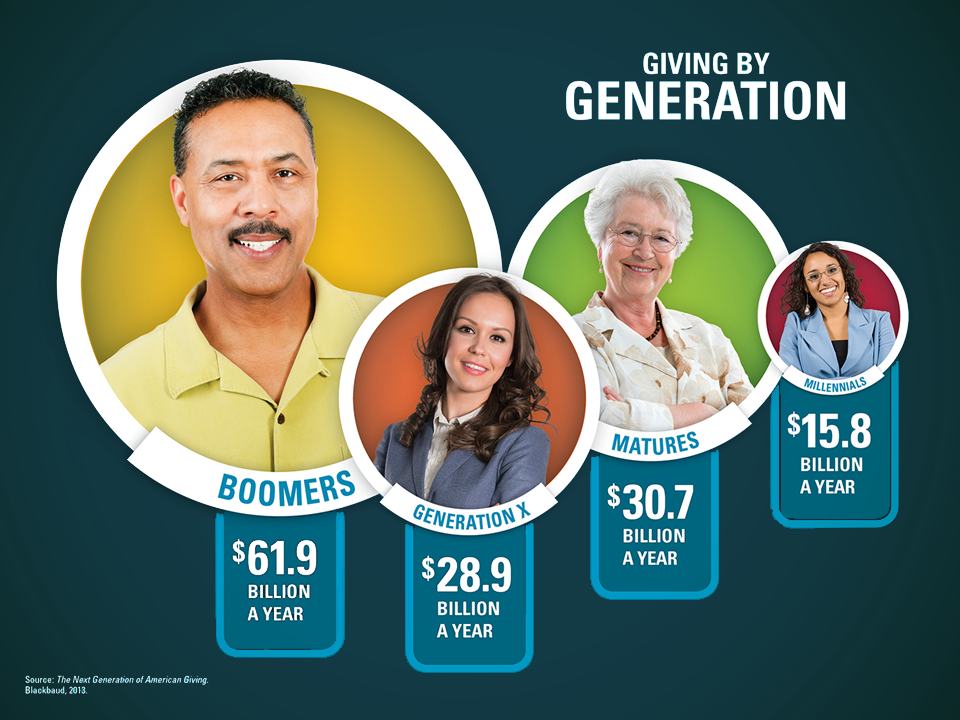
There is something about social media and online communications that leads many people to conclude that the up-and-coming Millennial cohort (the group on the right of the chart above) is where the money is.
Couple this conclusion with a “direct mail is dead” view, and you have a deadly combination of insider positions that will kill a major gift program.
Jeff and I have heard this hundreds of times: “Look, direct mail is for old people. We need to reach out to the new people. THAT is where the opportunity is!” And we reply: “Hold it, direct mail still works, as do many tried and true strategies. Don’t forget that most of the money that is given each year comes from those ‘old people’!”
Now I am not doing a defense of direct mail in this post. All I want to point out is that personal preference, not facts, often drives strategy design. Allowing that to happen will run your major gift program into the ground.
Why?
Because direct mail and “older” strategies most often fill the major gift pipeline. The fact is that the Millennial and GenX groups just do not give as much as the Boomers and Matures – at least not yet. And spending a ton of time trying to persuade them to give at the level the others give is a waste of time and resources.
“But he said at least not yet,” someone will say. “Richard acknowledged that they will, eventually, give more.” And that is the other trap fundraising strategists fall into – the belief that there is promise right around the corner, so you need to invest right now. Don’t do it – or if you do, do it carefully and thoughtfully.
Someone, when they read this, is likely to say that it is foolish not to do something with the younger generations. “They are our future, right?” I would agree – you should do something. You need to develop your social media and your online giving strategies. And you do need to have a space in your brain to design new and innovative approaches to these donors. And it needs to be done well. I agree, it is important to create relationships and offers for younger donors.
But my point is that you need to keep things balanced. Don’t do what Jeff and I heard in one meeting: “Look, we are a new and modern organization. Our brand is targeting younger people who want to make a difference. So using those strategies for older donors will not work for us.”
What?!?
Just think about this for a second. Those older donors are giving $92.6 billion while the younger donors are giving $44.7 billion and you are just going to ignore the older ones?!? Crazy – and stupid.
This is where people think that creating strategies, offers and asks for older donors will somehow hurt their brand. Like there are certain causes or societal problems that only young people care about. Hmmmm… See how this goes? It doesn’t make sense.
It is true that the $44.7 billion the younger donors are giving is nothing to sneeze at. But all Jeff and I are saying is this: do not ignore the older donors as you design your strategy for major gifts. They have the resources, and they want to help. Just because your cause is packaged as a hip modern trendy thing doesn’t mean the older donors won’t want to jump on board.
Why do I know this is true?
Because donors will give to the solution to the problem you are addressing, not to your nice, shiny, new, modern brand. It is the way you are addressing the societal problem. It is about how effective you are at using their money to do it. It is all of this that brings the donor on board to partner with you. Get that wrong, and no amount of brand dressing will help. Believe me. Get it right, and then add some good branding. But the core thing is the promise you can make to solve the problem.
Jeff and I and our team of Veritus Group colleagues spend a great deal of time thinking about all the donor groups. You should, too. Think and plan for all of them. Do not, because of personal preference, eliminate the older donors from your planning and thinking.
Richard


![A donor is showing her membership card. Moving Out of a Membership Mindset [Podcast Episode]](https://veritusgroup.com/wp-content/uploads/2022/08/Podcast-Episode-Blog-Post-Header-Image_081722.png)



Richard,
Enjoyed your post today,I was speaking with some of our AFP NWPA Chapter Board members on this exact topic yesterday at our board meeting, your article was right on target and great timing to reinforce my discussion..I sent it to them a few minutes ago..Thank you..
Gary Bukowski CFRE
Thank you for publishing such an important article. We have an aging donor base as a faith based organization and find that our continued investment in direct mail, despite the naysayers has been a substantial portion of our income. It has also proven to be a pipeline to major gifts but an incredible numbers of folks who leave us bequests. Thank you for always providing such useful information. Your staff speakers at national conferences and these kinds of articles have had a major impact on our work.